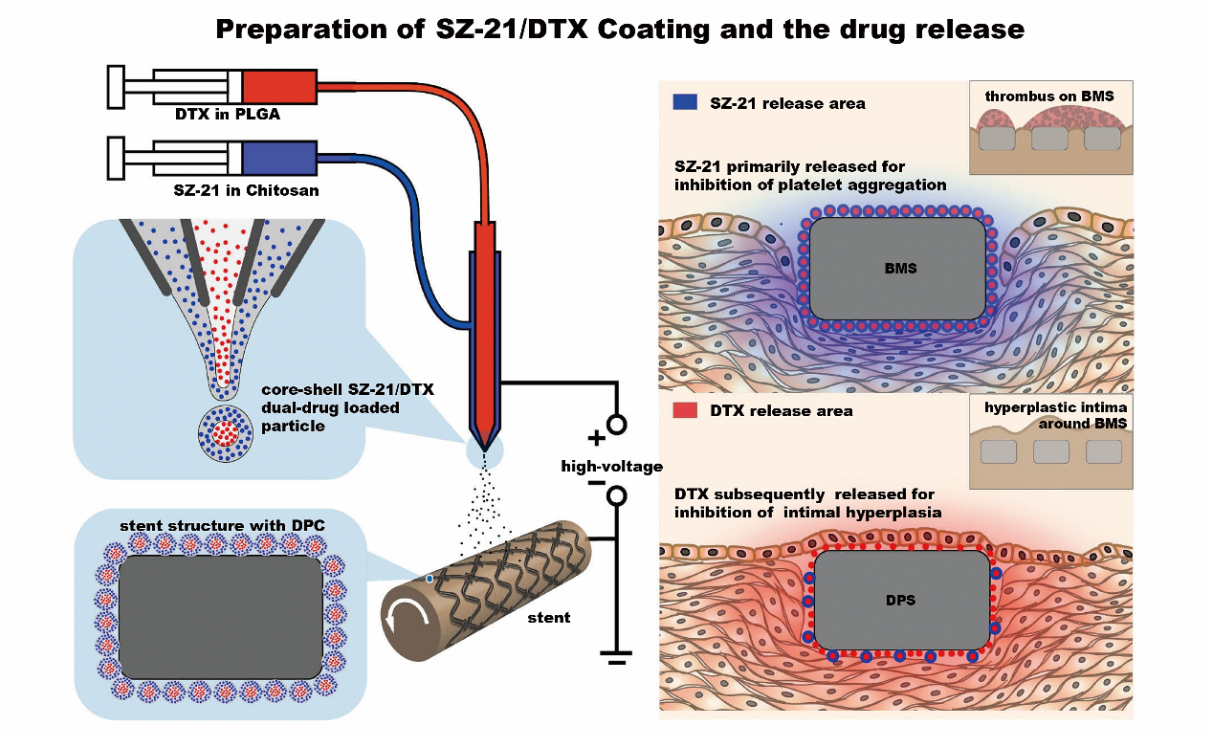The research paper titled “Design and testing of hydrophobic core/hydrophilic shell nano/micro particles for drug-eluting stent coating” completed by the team led by Professor Wang Guixue of the School of Bio-engineering of Chongqing University has been published in NPG Asia Materials (the average 3-year influence factor is 9.349) run by Nature Publishing Group on line as the cover paper (DOI: 10.1038/s41427-018-0064-z) the other day. The paper’s first author is Du Ruolin, a doctoral candidate of 2014, and Dr. Wang Yazhou, a young teacher, and the corresponding author is Professor Wang Guixue and Associate Professor Yin Tieying. Chongqing University is the first completion organization and the only corresponding author organization of this paper. This paper has been completed with long-term support for the animal experiment of Professor Du Dingyuan from the Affiliated Central Hospital of Chongqing University/Chongqing Emergency Center, and Chief Physician Li Zhenggong from the Intervention Department of the People’s Hospital of Chongqing. Dr. Sean McGinty from the University of Glasgow and Dr. Giuseppe Pontrelli from Applied Mathematics Research Institute of Italy, have both participated in the drug release simulation study as part of the research.

Fig. 1 The paper being published on the first page of the journal as the cover paper
According to the Report on Cardiovascular Disease of China in 2017, the cardiovascular mortality was 43% in urban areas and 45% in rural areas, and cardiovascular diseases have become the first cause of death from diseases among citizens, followed by cancers and other diseases. The percutaneous coronary intervention is an effective therapeutic approach for cardiovascular stricture and other similar diseases. In particular, the drug eluting stent can effectively reduce the occurrence rate of restenosis. However, implantation of the stent would result in a change of physiological environment of blood vessels, and cause gathering of blood platelets and inflammation. The stent coating may to a certain extent prevent restoration of damaged endothelium and delay covering of stent by new endothelium, thus extending the stimulation effect of stent and endothelial injury on blood platelet, and increasing occurrence of in-stent restenosis and late thrombosis. The key points of coating design proposed in this paper include improving the biological compatibility of the coating, seeking for more suitable drugs for vascular function, improving carrying mode of drugs, achieving time-ordered release of coating-entrapped new-type drugs by reasonable design, preventing early formation of local thrombosis and repairing injured endothelium of vessel in the stent section.
The team led by Professor Wang Guixue used the simple “one-step” co-axial electrostatic spraying method to prepare the double-drug-layer carrying stent made up of core-shell structure particles, where the particle shells could entrap anti-thrombosis drugs such as sz-21. The core layer could entrap drugs preventing proliferation of smooth muscle cells such as docetaxel. Such a coating design allows the two drugs to go through both the quick releasing process and slow releasing process, thus realizing time-ordered differential release of the two drugs, which is closer to the ideal releasing mode of stent drugs. In another word, it helps with repairing of injured endothelium, and may reduce the risk of in-stent restenosis and late thrombosis.

Fig. 2 Coating design and drug releasing principle
The hydrodynamic structure and particle size of the particles are controlled by changing and optimizing the spraying parameters, so as to meet the need of release of more drugs, thus obtaining better blood vessel endothelium. At the same time, the coating preparation method proposed in this paper can also be used for more implants such as degradable intravascular stent, artificial blood vessel and orthopedic stent, without requiring expensive instrument or devices or complicated surface treatment. This will be very advantageous when it comes to industrialized production in the future.
The research has been substantially supported by the Major Project Program (2012BAI18B02) of National Sci-tech Support Plan under the 12th Five-year Plan, the National Key R&D Project Program (2016YFC1102305) under the 13th Five-year Plan, the Major Project Program of the Natural Science Foundation of China (11332003), the Central Research Fund for Colleges and University (106112017CDJPT230001, 106112017CDJZRPY 0202) and other programs. Academician of Ruan Changgeng from Suzhou University, Professor Liu Lushan from University of South China, Professor Richard Nowakowski from the University of Florida, and Professor of Hossam Haick from Technion-Israel Institute of Technology, and Beijing AMSINO have offered assistance. Two national patents for invention and one American patent for invention have been granted.
Link of the paper: https://www.nature.com/articles/s41427-018-0064-z

